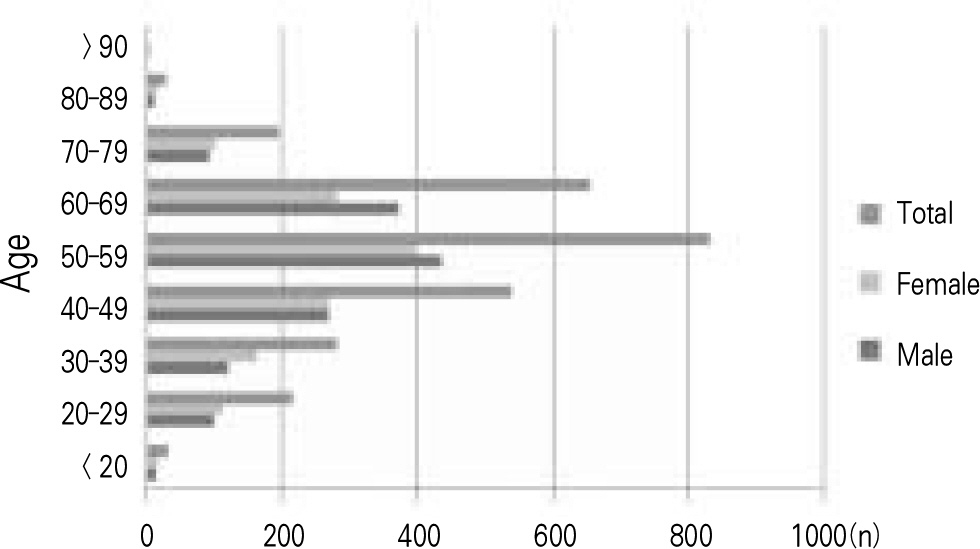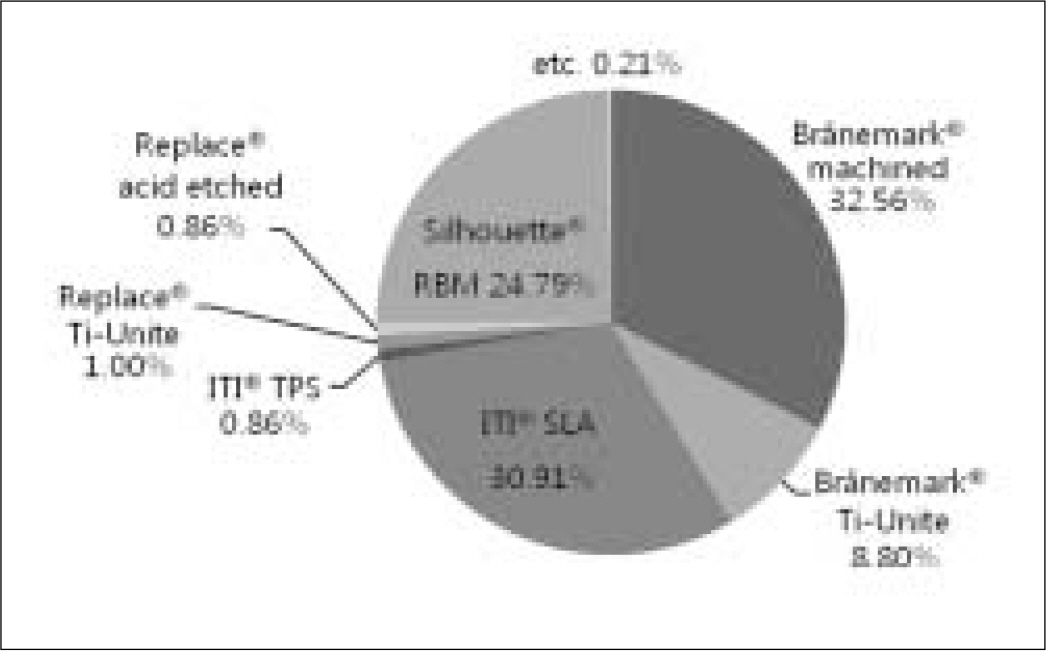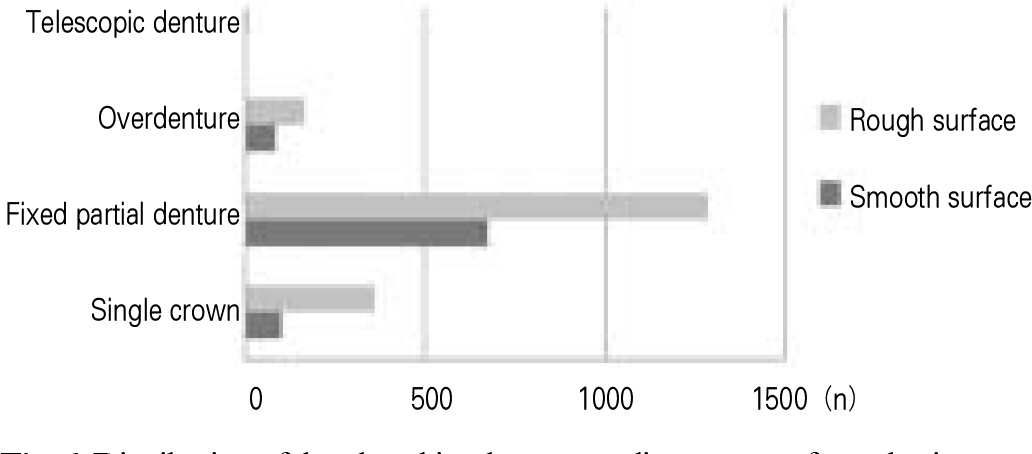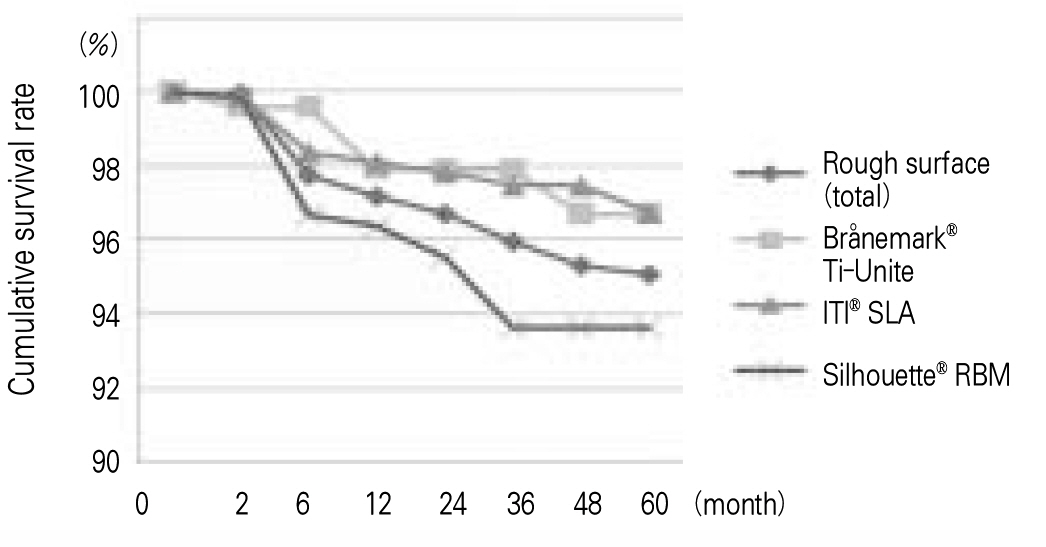J Korean Acad Prosthodont.
2010 Jan;48(1):28-40. 10.4047/jkap.2010.48.1.28.
The effects of local factors on the survival of dental implants: A 19 year retrospective study
- Affiliations
-
- 1Department of Prosthetic Dentistry, The Graduate School, Yonsei University, Seoul, Korea. donghoohan@yuhs.ac
- KMID: 2000318
- DOI: http://doi.org/10.4047/jkap.2010.48.1.28
Abstract
- PURPOSE
The aim of this retrospective study was to provide long-term data about the correlation between multifactorial local factors and the survival of implants. MATERIAL AND METHODS: During 19 years (1991 to 2009), 2796 implants were placed in 879 patients. From dental charts and radiographs, the following data were collected: patient's age at implant placement, gender, implant system, surface, length, diameter, location of implant placement, bone quality, primary stability, type of prosthesis. The correlations between these data and implant survival were analyzed. Statistical analysis was performed using Kaplan-Meier survival analysis, Chi-square test, odds ratio.
RESULTS
1. Among the 2796 implants, 150 implants failed that resulted in a cumulative survival rate of 94.64%. The cumulative survival rate of smooth surface implants (91.76%) was lower than rough surface implants (96.02%). 2. Anatomic location, implant surface, diameter of smooth surface implant, primary stability, type of prosthesis, patient's age and gender were significantly associated with implant survival (P < .05). 3. No significant difference in implant survival was found in relation to the following factors: implant length, bone quality, diameter of rough surface implants and type of rough surface according to implant manufacturer (P < .05).
CONCLUSION
Local factors such as anatomic location, implant surface, diameter of smooth surface implant, primary stability and type of prosthesis have a significant effect on implant survival.
Keyword
MeSH Terms
Figure
Cited by 2 articles
-
Analysis of thermal changes in bone by various insertion torques with different implant designs
Min-Ho Kim, In-Sung Yeo, Sung-Hun Kim, Jung-Seok Han, Jai-Bong Lee, Jae-Ho Yang
J Korean Acad Prosthodont. 2011;49(2):168-176. doi: 10.4047/jkap.2011.49.2.168.Stress dissipation characteristics of four implant thread designs evaluated by 3D finite element modeling
Ok-Hyun Nam, Won-Jae Yu, Hee-Moon Kyung
J Korean Acad Prosthodont. 2015;53(2):120-127. doi: 10.4047/jkap.2015.53.2.120.
Reference
-
1.Adell R., Lekholm U., Rockler B., Bra � nemark PI. A 15-year study of osseointegrated implants in the treatment of the edentulous jaw. Int J Oral Surg. 1981. 10:387–416.
Article2.Adell R., Eriksson B., Lekholm U., Bra � nemark PI., Jemt T. Long-term follow-up study of osseointegrated implants in the treatment of totally edentulous jaws. Int J Oral Maxillofac Implants. 1990. 5:347–59.3.Buser D., Mericske-Stern R., Bernard JP., Behneke A., Behneke N., Hirt HP., Belser UC., Lang NP. Long-term evaluation of non-submerged ITI implants. Part 1: 8-year life table analysis of a prospective multicenter study with 2359 implants. Clin Oral Implants Res. 1997. 8:161–72.
Article4.Esposito M., Grusovin MG., Coulthard P., Thomsen P., Worthington HV. A 5-year follow-up comparative analysis of the efficacy of various osseointegrated dental implant systems: a systematic review of randomized controlled clinical trials. Int J Oral Maxillofac Implants. 2005. 20:557–68.5.Romeo E., Lops D., Margutti E., Ghisolfi M., Chiapasco M., Vogel G. Long-term survival and success of oral implants in the treatment of full and partial arches: a 7-year prospective study with the ITI dental implant system. Int J Oral Maxillofac Implants. 2004. 19:247–59.6.Han DH., Bae EK. Longitudinal clinical study on the efficacy of osseointegrated dental implants in partially edentulous Korean patients: an 8-years prospective study. J Korean Acad Prosthodont. 2001. 39:698–708.7.Seo JY., Shim JS., Lee JH., Lee KW. Clinical and radiographical evaluation of implant-supported fixed partial prostheses. J Korean Acad Prosthodont. 2006. 44:394–404.8.el Askary AS., Meffert RM., Griffin T. Why do dental implants fail? Part I. Implant Dent. 1999. 8:173–85.
Article9.el Askary AS., Meffert RM., Griffin T. Why do dental implants fail? Part II. Implant Dent. 1999. 8:265–77.
Article10.Albrektsson T., Bra � nemark PI., Hansson HA., Lindstro ¨m J. Osseointegrated titanium implants. Requirements for ensuring a long-lasting, direct bone-to-implant anchorage in man. Acta Orthop Scand. 1981. 52:155–70.11.Esposito M., Hirsch JM., Lekholm U., Thomsen P. Biological factors contributing to failures of osseointegrated oral implants. (II). Etiopathogenesis. Eur J Oral Sci. 1998. 106:721–64.
Article12.Tonetti MS., Schmid J. Pathogenesis of implant failures. Periodontol 2000. 1994. 4:127–38.
Article13.Albrektsson T., Dahl E., Enbom L., Engevall S., Engquist B., Eriksson AR., Feldmann G., Freiberg N., Glantz PO., Kjellman O, et al. Osseointegrated oral implants. A Swedish multicenter study of 8139 consecutively inserted Nobelpharma implants. J Periodontol. 1988. 59:287–96.14.Buser D., Weber HP., Lang NP. Tissue integration of non-submerged implants. 1-year results of a prospective study with 100 ITI hollow-cylinder and hollow-screw implants. Clin Oral Implants Res. 1990. 1:33–40.15.Cochran DL., Buser D., ten Bruggenkate CM., Weingart D., Taylor TM., Bernard JP., Peters F., Simpson JP. The use of reduced healing times on ITI implants with a sandblasted and acid-etched (SLA) surface: early results from clinical trials on ITI SLA implants. Clin Oral Implants Res. 2002. 13:144–53.16.Bryant SR. The effects of age, jaw site, and bone condition on oral implant outcomes. Int J Prosthodont. 1998. 11:470–90.17.Shirota T., Ohno K., Suzuki K., Michi K. The effect of aging on the healing of hydroxylapatite implants. J Oral Maxillofac Surg. 1993. 51:51–6.18.Smith RA., Berger R., Dodson TB. Risk factors associated with dental implants in healthy and medically compromised patients. Int J Oral Maxillofac Implants. 1992. 7:367–72.19.Schwartz-Arad D., Laviv A., Levin L. Failure causes, timing, and cluster behavior: an 8-year study of dental implants. Implant Dent. 2008. 17:200–7.
Article20.Wagenberg B., Froum SJ. A retrospective study of 1925 consecutively placed immediate implants from 1988 to 2004. Int J Oral Maxillofac Implants. 2006. 21:71–80.21.Misch CE. Short dental implants: a literature review and rationale for use. Dent Today. 2005. 24:64–6. 68.22.Renouard F., Nisand D. Impact of implant length and diameter on survival rates. Clin Oral Implants Res. 2006. 17:35–51.
Article23.Ivanoff CJ., Gro ¨ndahl K., Sennerby L., Bergstro ¨m C., Lekholm U. Influence of variations in implant diameters: a 3- to 5-year retrospective clinical report. Int J Oral Maxillofac Implants. 1999. 14:173–80.24.Shin SW., Bryant SR., Zarb GA. A retrospective study on the treatment outcome of wide-bodied implants. Int J Prosthodont. 2004. 17:52–8.25.Meredith N., Shagaldi F., Alleyne D., Sennerby L., Cawley P. The application of resonance frequency measurements to study the stability of titanium implants during healing in the rabbit tibia. Clin Oral Implants Res. 1997. 8:234–43.
Article26.Huwiler MA., Pjetursson BE., Bosshardt DD., Salvi GE., Lang NP. Resonance frequency analysis in relation to jawbone characteristics and during early healing of implant installation. Clin Oral Implants Res. 2007. 18:275–80.
Article27.Rabel A., Ko ¨hler SG., Schmidt-Westhausen AM. Clinical study on the primary stability of two dental implant systems with resonance frequency analysis. Clin Oral Investig. 2007. 11:257–65.
Article28.Park JH., Lim YJ., Kim MJ., Kwon HB. The effect of various thread designs on the initial stability of taper implants. J Adv Prosthodont. 2009. 1:19–25.
Article29.O' Sullivan D., Sennerby L., Meredith N. Measurements comparing the initial stability of five designs of dental implants: a human cadaver study. Clin Implant Dent Relat Res. 2000. 2:85–92.30.Alves CC., Neves M. Tapered implants: from indications to advantages. Int J Periodontics Restorative Dent. 2009. 29:161–7.31.Iezzi G., Degidi M., Scarano A., Perrotti V., Piattelli A. Bone response to submerged, unloaded implants inserted in poor bone sites: a histological and histomorphometrical study of 8 titanium implants retrieved from man. J Oral Implantol. 2005. 31:225–33.
Article32.Kim NS., Vang MS., Yang HS., Park SW., Lim HP. Comparion of stability in titanium implants with different surface topographies in dogs. J Adv Prosthodont. 2009. 1:47–55.
Article33.Cochran DL. The evidence for immediate loading of implants. J Evid Based Dent Pract. 2006. 6:155–63.
Article34.Goodacre CJ., Bernal G., Rungcharassaeng K., Kan JY. Clinical complications with implants and implant prostheses. J Prosthet Dent. 2003. 90:121–32.
Article35.Bryant SR., MacDonald-Jankowski D., Kim K. Does the type of implant prosthesis affect outcomes for the completely edentulous arch? Int J Oral Maxillofac Implants. 2007. 22:117–39.36.Weber HP., Sukotjo C. Does the type of implant prosthesis affect outcomes in the partially edentulous patient? Int J Oral Maxillofac Implants. 2007. 22:140–72.37.Esposito M., Hirsch J., Lekholm U., Thomsen P. Differential diagnosis and treatment strategies for biologic complications and failing oral implants: a review of the literature. Int J Oral Maxillofac Implants. 1999. 14:473–90.38.Weaver AL., Assad DA., Koka S., Eckert SE., Balshe A. The effects of smoking on the survival of smooth- and rough-surface dental implants. Int J Oral Maxillofac Implants. 2008. 23:1117–22.39.Esposito M., Hirsch JM., Lekholm U., Thomsen P. Biological factors contributing to failures of osseointegrated oral implants. (I). Success criteria and epidemiology. Eur J Oral Sci. 1998. 106:527–51.
Article40.Rabel A., Ko ¨hler SG., Schmidt-Westhausen AM. Clinical study on the primary stability of two dental implant systems with resonance frequency analysis. Clin Oral Investig. 2007. 11:257–65.
Article41.Chuang SK., Cai T., Douglass CW., Wei LJ., Dodson TB. Frailty approach for the analysis of clustered failure time observations in dental research. J Dent Res. 2005. 84:54–8.
Article42.Weyant RJ., Burt BA. An assessment of survival rates and within-patient clustering of failures for endosseous oral implants. J Dent Res. 1993. 72:2–8.
Article
- Full Text Links
- Actions
-
Cited
- CITED
-
- Close
- Share
- Similar articles
-
- A retrospective study on related factors affecting the survival rate of dental implants
- A retrospective study of survival rate of dental implants placed in osteoporosis patients
- Cumulative survival rate and associated risk factors of Implantium implants: A 10-year retrospective clinical study
- A 10-year retrospective clinical study of Branemark implants
- Factors affecting the survival of implants: a long-term retrospective study









